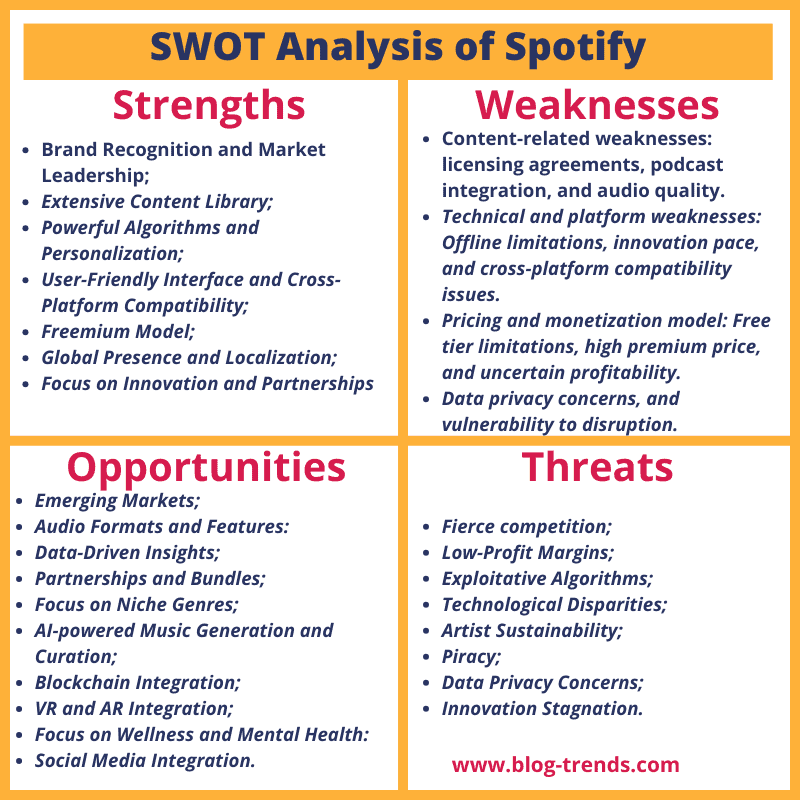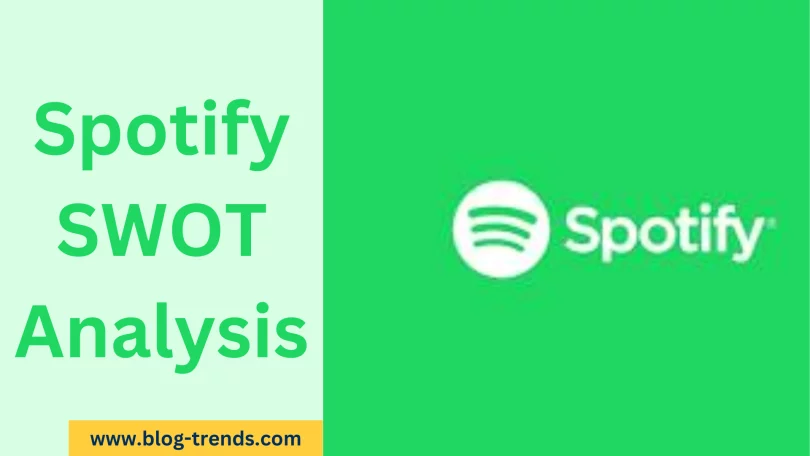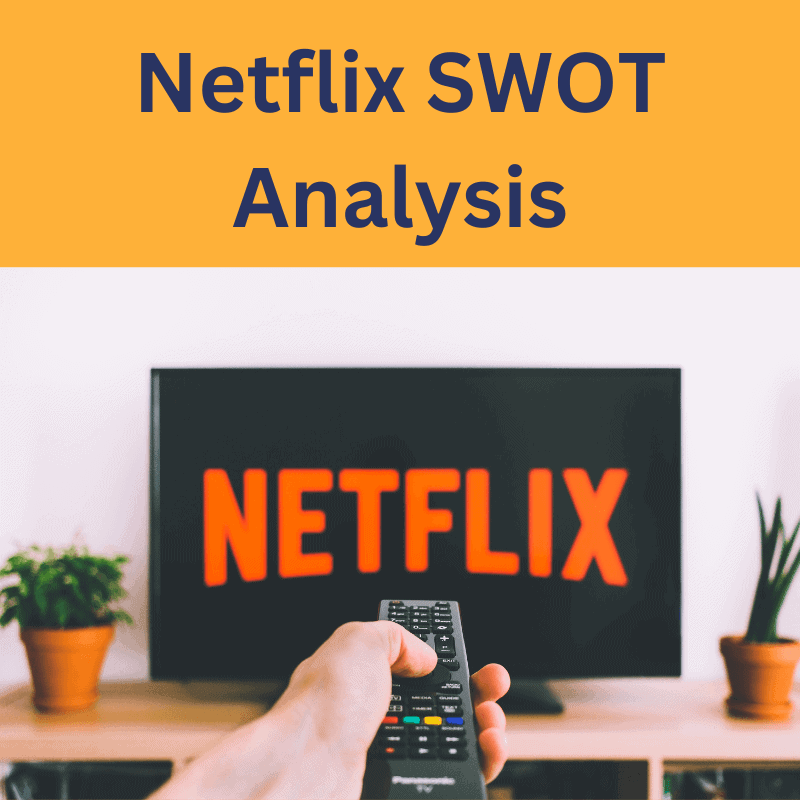In the symphony of streaming platforms, Spotify produces a unique melody, captivating millions with its innovation and content curation rhythm.
A closer look at Spotify through the lens of a SWOT analysis reveals the complex interplay between its harmonic success and the dynamic landscape of the music streaming industry.
Beyond the beats and playlists lies a narrative of strategic maneuvers and challenges in a world where every note resonates with opportunity and threat.
This introduction sets the stage by comparing Spotify’s presence in the music streaming industry to a symphony. It emphasizes its unique position while hinting at the complexity and strategic nuances explored through the SWOT analysis.
Spotify SWOT Analysis
Spotify overview
Spotify, synonymous with on-demand music, has revolutionized the audio landscape. This section delves into the depths of this audio giant, exploring its history, activities, competitors, suppliers, customers, strategies, and key figures.
A Melodious Journey Through Time: Spotify’s History
Spotify’s story began in 2006, a brainchild of Daniel Ek and Martin Lorentzon in Sweden. Frustrated by rampant music piracy, they envisioned a legal and convenient music streaming platform.
In 2008, Spotify launched in Europe, facing initial challenges from record labels. However, its freemium model (combining free ad-supported and paid ad-free tiers) proved a game-changer, attracting millions of users.
Beyond Music: Spotify’s Diversified Activities
While music remains its core, Spotify has expanded its horizons. Today, it boasts:
- Podcasts: With over 4 million podcasts, Spotify has become a leading platform catering to diverse tastes and interests.
- Audiobooks: Expanding its reach beyond music, Spotify ventured into audiobooks, offering a comprehensive library for listeners.
- Live Events: Capitalizing on its user base, Spotify organizes live music events and experiences, fostering deeper connections between artists and fans.
Facing the Beat: Spotify’s Competitors
The music streaming battlefield is crowded, with Spotify facing stiff competition from:
- Apple Music: With tight integration into Apple’s ecosystem and exclusive content, Apple Music attracts loyal Apple users.
- Amazon Music: With Prime subscriptions and high-quality audio options, Amazon Music poses a substantial challenge.
- YouTube Music: Leveraging YouTube’s vast music library and video integration, YouTube Music offers a unique proposition.
Behind the Curtain: Spotify’s Suppliers and Customers
Spotify’s success hinges on crucial partnerships:
- Record Labels: Major labels like Universal Music Group and Sony Music Entertainment supply the vast music library.
- Content Creators: Musicians, podcasters, and audiobook narrators are the platform’s lifeblood.
Spotify caters to a diverse customer base:
- Music Enthusiasts: Spotify offers something for everyone, from casual listeners to audiophiles.
- Podcast Devotees: Podcast fans rely on Spotify for their daily dose of spoken-word content.
- Tech-Savvy Individuals: Those seeking a seamless and personalized audio experience find Spotify’s features and algorithms appealing.
Dancing to the Rhythm: Spotify’s Strategies
Spotify’s strategic playbook includes:
- Content Acquisition: Continuously expanding its music library, acquiring podcast studios, and investing in original content.
- Personalization: Utilizing sophisticated algorithms to recommend music and podcasts tailored to individual preferences.
- Tech Innovation: It is constantly upgrading its platform with features like AI-powered DJ and spatial audio.
- Global Expansion: Entering new markets and adapting to local preferences to reach a wider audience.
The Numbers Game: Spotify’s Key Figures
As of November 2023:
- Monthly Active Users (MAUs): 456 million
- Premium Subscribers: 195 million
- Presence: Over 180 countries
- Revenue (2022): €9.8 billion
The Future Symphony: What’s Next for Spotify?
Spotify’s future looks bright, with opportunities in:
- AI-powered personalization: Leveraging AI to create even more immersive and customized listening experiences.
- Live streaming and virtual concerts: Providing interactive and engaging live music experiences within the platform.
- Expanding into new markets: Focusing on emerging markets with high growth potential.
Spotify’s journey is far from over. With its commitment to innovation, diverse content, and user-centric approach, Spotify is poised to continue its reign as the king of audio streaming, shaping the future of how we listen to music, podcasts, and more.
Then, we have conducted a literature review on the music streaming industry. In parallel, we have conducted an in-depth analysis of Spotify’s website and key figures. As a result, we present below the Spotify SWOT analysis.
The internal analysis of Spotify
SWOT is a strategic planning tool that allows us to analyze a company’s strengths and weaknesses, determine its future expansion strategies, and consider the opportunities and threats of its current markets.
In this section, we will focus on analyzing the strengths and weaknesses of Spotify to discover the various internal factors.
The strengths of Spotify
Spotify boasts several vital strengths that give it an edge over its competitors in the music streaming market. Here’s a comprehensive overview of Spotify strengths:
Brand Recognition and Market Leadership:
Spotify is the first mover in the music streaming scene and has solidified its position as a household name with high brand recognition. This gives them an advantage in attracting new users and retaining existing ones.
Extensive Content Library:
Spotify offers a vast music library, encompassing millions of songs from a wide range of genres and eras. They also invest in podcasts and audiobooks, making them a one-stop shop for many users’ audio needs.
Powerful Algorithms and Personalization:
Spotify’s recommendation algorithms are renowned for their accuracy, suggesting music and podcasts that users are highly likely to enjoy. This personalized experience keeps users engaged and coming back for more.
User-Friendly Interface and Cross-Platform Compatibility:
Spotify’s intuitive interface and seamless integration across various devices, including smartphones, tablets, computers, smart speakers, and TVs, make it easy for users to access their content anywhere, anytime.
Freemium Model:
Spotify’s freemium model (offering a free ad-supported tier alongside a premium ad-free tier) balances accessibility with monetization, attracting a broader audience than pure subscription-based models.
Global Presence and Localization:
Spotify operates in over 180 countries, adapting its content and features to local preferences. This global reach provides significant growth potential compared to competitors with a smaller footprint.
Focus on Innovation and Partnerships:
Spotify actively invests in technological innovation, experimenting with features like AI-powered DJs and spatial audio, and regularly partners with artists and labels for exclusive content and experiences.
While Spotify faces competition from Apple Music, Amazon Music, and YouTube Music, these strengths give them a significant advantage. Their brand recognition, personalized experience, extensive content library, and commitment to innovation will likely remain critical factors in their continued success.
It’s important to note that the industry is constantly evolving, and other players may develop new strengths or exploit Spotify’s weaknesses.
However, Spotify’s current strengths position them well to maintain their leadership in the music streaming market for the foreseeable future.
The weaknesses of Spotify
Spotify, while a dominant force in music streaming, has weaknesses its competitors can exploit to gain an edge. Here are some key points:
Content-related weaknesses:
- Licensing Agreements: Incomplete content due to missing artists or regional restrictions can push users towards platforms with more comprehensive libraries.
- Podcast integration: Unlike dedicated podcast platforms, Spotify’s features may feel clunky or lack desired functions.
- Audio quality: While not a dealbreaker for everyone, competitors like Tidal and Qobuz offer higher fidelity options for audiophiles, a niche Spotify might lose.
Technical and platform weaknesses:
- Offline limitations: Some free tier limitations on offline listening can be inconvenient compared to competitors who offer more offline flexibility.
- Innovation pace: While Spotify innovates, some users feel competitors like YouTube Music are quicker to adopt new features or offer unique experiences.
- Cross-platform compatibility issues: Occasional hiccups with integrations or inconsistent experiences across different devices can frustrate users.
Pricing and monetization model:
- Free tier limitations: The heavy reliance on ad revenue and constraints placed on the free tier can alienate some users who might find similar experiences elsewhere without ads.
- High premium price: Unlike some competitors, Spotify’s premium tier price might be considered expensive for specific user segments.
- Uncertain profitability: Despite impressive user numbers, Spotify has yet to consistently turn a profit, which can raise concerns about its long-term sustainability.
Other potential weaknesses:
- Data privacy concerns: Spotify’s data collection practices raise concerns for some users, giving competitors who emphasize privacy a potential advantage.
- Artist-to-fan connection: Critics argue that Spotify’s focus on algorithms and data might hinder direct connection and support between artists and fans.
- Vulnerability to disruption: Reliance on third-party content makes Spotify susceptible to changes in licensing agreements or new technological advancements that could disrupt its model.
Spotify’s success will ultimately depend on how effectively it addresses these weaknesses while maintaining its strengths and adapting to a constantly evolving market.
The external analysis of Spotify
The primary goal of external analysis is to identify and assess the external factors that influence a company’s business environment.
The opportunities of Spotify
The global music streaming market is a thriving space with immense potential for growth and innovation. Here’s a breakdown of the current and potential opportunities for Spotify:
Current Opportunities:
Expanding Market: The market is projected to reach over $22 billion by 2030, indicating continuous user growth and revenue potential.
Emerging Markets: Untapped potential in developing countries with high internet penetration and growing disposable income presents tremendous expansion opportunities.
Audio Formats and Features: Experimentation with spatial audio, live streaming, and interactive elements can attract new audiences and enhance user engagement.
Data-Driven Insights: Leveraging user data to personalize recommendations, curated playlists, and tailor marketing strategies can increase user retention and satisfaction.
Partnerships and Bundles: Collaborating with mobile carriers, smart speaker companies, and other entertainment platforms can expand reach and offer bundled services for increased value.
Focus on Niche Genres: Catering to specific musical tastes and communities with dedicated content and features can attract loyal fanbases and differentiate platforms.
Potential Opportunities:
AI-powered Music Generation and Curation: Utilizing AI to generate personalized playlists, DJ mixes, and even original music based on user preferences could revolutionize the listening experience.
Blockchain Integration: Blockchain technology could enable secure and transparent music distribution, fairer artist compensation, and new monetization models like tokenization of songs or artist shares.
VR and AR Integration: Virtual and augmented reality experiences could offer immersive concert simulations, interactive music videos, and innovative fan engagement opportunities.
Focus on Wellness and Mental Health: Curating music and soundscapes for specific moods, activities, or mental health needs could tap into a growing wellness market.
Direct-to-Fan Platforms: Building features that facilitate direct interaction and support between artists and fans, like merchandise sales, crowdfunding, or exclusive content, could foster stronger artist communities.
Social Media Integration: Deeper integration with social media platforms could allow for music sharing, collaborative playlists, and real-time reactions to music, enhancing the social aspect of listening.
By seizing these opportunities and addressing the industry’s challenges, music streaming platforms like Spotify can continue to thrive and shape the future of how we experience music.
The threats of Spotify
The music streaming industry, despite its massive rise in popularity, faces several significant challenges and threats:
Market Saturation: The competition is fierce, with major players like Apple Music, Amazon Music, and YouTube Music vying for subscribers. This saturation makes it difficult for Spotify to attract new users.
Low-Profit Margins: The subscription fees that platforms charge users often translate to small payouts for artists and rights holders. This has led to criticism about the unfair distribution of revenue within the industry.
Exploitative Algorithms: Platforms rely heavily on algorithms to recommend music to users, which can lead to echo chambers and limit exposure for smaller artists and diverse genres. Additionally, concerns exist about algorithmic bias and manipulation.
Technological Disparities: Access to high-speed internet remains a barrier for many, particularly in developing countries. This limits the potential reach of streaming services and excludes a large audience from the music conversation.
Artist Sustainability: While streaming has made music readily available, the low payouts can make it difficult for artists, especially niche genres, to earn a living solely from their music. This can hinder artistic development and limit diversity in the industry.
Piracy: Despite advancements in anti-piracy measures, illegal access to music remains a challenge. This cuts into potential revenue for both platforms and artists and undermines the legitimacy of the streaming model.
Data Privacy Concerns: Streaming platforms collect vast amounts of user data, raising concerns about privacy and potential misuse. Building trust with users and ensuring transparency regarding data usage is crucial.
Innovation Stagnation: While some platforms offer features like podcasts and audiobooks, there needs to be more growth regarding how users experience music within the streaming environment. Exploring new ways to engage listeners and differentiate platforms is essential.
By tackling these challenges, the music streaming industry can continue to thrive and provide a sustainable and rewarding experience for all stakeholders.
SWOT Analysis Matrix of Spotify
To summarize the results of the Spotify SWOT analysis, we present the following SWOT matrix:

Conclusion
To leverage its opportunities, Spotify must focus on several key strategies. Firstly, it must prioritize user experience by refining interfaces and delivering personalized recommendations and diverse content.
This approach aims to cater to the varied preferences of its vast user base, enhancing engagement and satisfaction. Additionally, embracing innovation is crucial for Spotify to maintain a competitive edge.
Continual investment in new technologies and features enables the platform to differentiate itself and stay ahead in the rapidly evolving music streaming industry.
Furthermore, supporting artists and labels is pivotal. Spotify should ensure fair compensation models while equipping creators with discovery and promotion tools. This fosters a symbiotic relationship, benefiting both the platform and the artists.
Adapting to local markets is another essential strategy. Understanding cultural nuances and customizing content and features for specific regions can significantly enhance Spotify’s appeal and accessibility on a global scale.
Addressing these challenges demands collaborative efforts from various stakeholders, including platforms, artists, regulators, and users. Proposed solutions encompass fairer revenue-sharing models, advocating for algorithm diversity to promote a broader spectrum of artists, ensuring access to underserved areas, and prioritizing robust data privacy measures.
Such collaborative initiatives aim to create a more equitable and diverse music streaming ecosystem while meeting evolving user expectations and industry standards.
Read also: PESTEL Analysis of Spotify
SWOT Analysis Examples 2024
There is no better way to understand how to conduct a SWOT analysis at your company than with a concrete example.
Below you will find our free, up-to-date, and concrete examples of SWOT analyses of large companies and multinationals conducted in 2024.


















Leave a Comment